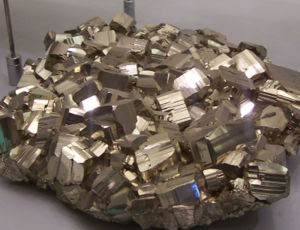
Copper is a chemical element with the symbol Cu (Latin: cuprum) and atomic number 29. It is a ductile metal with very high thermal and electrical conductivity. Pure copper is rather soft and malleable and a freshly-exposed surface has a pinkish or peachy color. Gold, caesium and copper are the only metallic elements with a natural color other than gray or white. It is used as a thermal conductor, an electrical conductor, a building material, and a constituent of various metal alloys.
Copper compounds are known in several oxidation states, usually 2+, where they often impart blue or green colors to natural minerals such as turquoise and have been used historically widely as pigments. Copper as both metal and pigmented salt, has a significant presence in decorative art.
Copper 2+ ions are soluble in water, where they function at low concentration as bacteriostatic substances and fungicides. For this reason copper metal can be used as an anti-germ surface that can add to the anti-bacterial and antimicrobial features of buildings such as hospitals.
Copper has a reddish, orangish, or brownish color because a thin layer of tarnish (including oxides) gradually forms on its surface when gases (especially oxygen) in the air react with it. But pure copper, when fresh, is actually a pinkish or peachy metal. When copper is burnt in oxygen it gives off a black oxide.
Copper can be found as native copper in mineral form (for example, in Michigan's Keewenaw Peninsula). Minerals such as the sulfides: chalcopyrite (CuFeS2), bornite (Cu5FeS4), covellite (CuS), chalcocite (Cu2S) are sources of copper, as are the carbonates: azurite (Cu3(CO3)2(OH)2) and malachite (Cu2CO3(OH)2) and the oxide: cuprite (Cu2O).
Copper is easily worked, being both ductile and malleable. The ease with which it can be drawn into wire makes it useful for electrical work in addition to its excellent electrical properties. Copper can be machined, although it is usually necessary to use an alloy for intricate parts, such as threaded components, to get really good machinability characteristics. Good thermal conduction make it useful for heatsinks and in heat exchangers. Copper has good corrosion resistance, but not as good as gold. It has excellent brazing and soldering properties and can also be welded, although best results are obtained with gas metal arc welding.
Copper is normally supplied, as with nearly all metals for industrial and commercial use, in a fine grained polycrystalline form. Polycrystalline metals have greater strength than monocrystalline forms, and the difference is greater for smaller grain (crystal) sizes. The reason is due to the inability of stress dislocations in the crystal structure to cross the grain boundaries.
Copper is malleable and ductile and is a good conductor of both heat and electricity Read More








